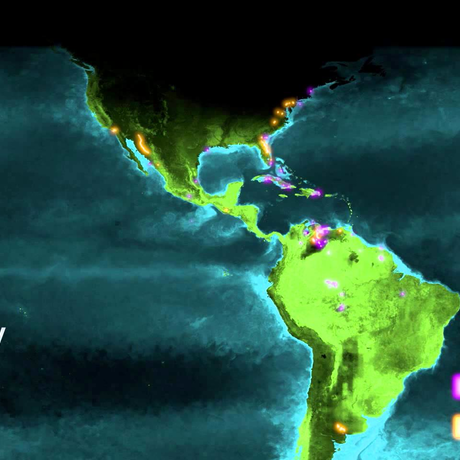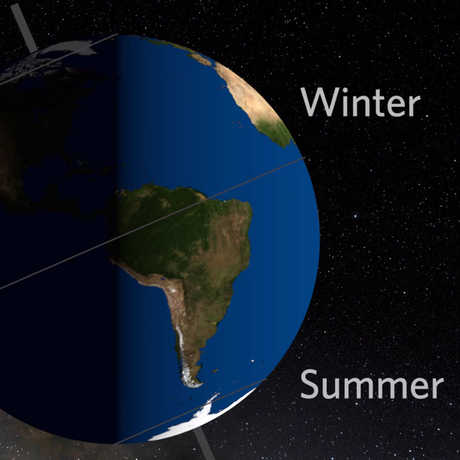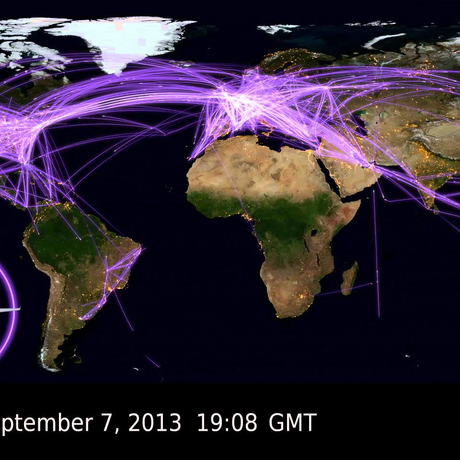Browse a rich array of educational resources from the award-winning show, Habitat Earth.
Historic population and cropland data illustrate the relationship between the spread of human civilization and agriculture on Earth between 10,000 BCE and 2,000 CE.
Guiding Questions
- How are human population centers and areas of agricultural use related in space and time? For instance, does agriculture expand out from city-centers? Which comes first—a cluster of humans and then agriculture?
- Are there time periods when the spread of agriculture moved at a quicker pace than others? Why might this be so?
- What characteristics of geography—especially climate, elevation, and soil type—may have influenced the amount and type of agriculture established in various sites around the world?
Sample Lesson that Directly Integrates This Science Visualization

Agriculture + Human Population Growth (grades 6-11)
Trace patterns of agricultural expansion through space and time, especially as they relate to climate and geography. How are patterns of human settlement and human population growth linked? Do you see evidence for how agriculture spread and retreated from different places based on historical events?
Connections to Standards
Next Generation Science Standards Disciplinary Core Ideas
- ESS3.A: Natural Resources
- (6-8) Humans depend on Earth's land, ocean, atmosphere, and biosphere for many different resources. Minerals, fresh water, and biosphere resources are limited, and many are not renewable or replaceable over human lifetimes.
- (9-12) Resource availability has guided the development of human society.
- ESS3.C: Human Impacts on Earth Systems:
- (5) Human activities in agriculture, industry, and everyday life have had major effects on the land, vegetation, streams, ocean, air, and even outer space. But individuals and communities are doing things to help protect Earth's resources and environments.
- (6-8) Human activities have significantly altered the biosphere, sometimes damaging or destroying natural habitats and causing the extinction of other species. But changes to Earth's environments can have different impacts (negative and positive) for different living things. Typically as human populations and per-capita consumption of natural resources increase, so do the negative impacts on Earth unless the activities and technologies involved are engineered otherwise.
- (9-12) The sustainability of human societies and the biodiversity that supports them requires responsible management of natural resources.
California's Environmental Principles and Concepts
- Principle I: The continuation and health of individual human lives and of human communities and societies depend on the health of the natural systems that provide essential goods and ecosystem services.
- Concept a: Students need to know that the goods produced by natural systems are essential to human life and to the functioning of our economies and cultures.
- Principle III: Natural systems proceed through cycles that humans depend upon, benefit from, and can alter.
- Concept b: Students need to know that human practices depend upon and benefit from the cycles and processes that operate within natural systems.
California History and Social Studies Standards
Depending on the History and Social Studies content standards you are covering in your K-12 classroom, this visualization may serve useful, even as a “hook” to capture students attention for a new unit of study.
Vocabulary for Students
- agriculture: the production of crops, livestock, or poultry; farming
- climate: the average, long-term conditions of temperature, precipitation, winds, and clouds in an area
- civilization: a human society that has highly developed material and spiritual resources and a complex cultural, political, and legal organization; an advanced state in social development
- society: a highly structured system of human organization for large-scale community living that normally furnishes protection, continuity, security, and a national identity for its members
- population: the number of inhabitants of a place, or belonging to a specific social, cultural, socioeconomic, ethnic, or racial subgroup
- migration: the process of moving from one country, region, or place to another
- geography: the study of the natural features of the earth's surface, including topography, climate, soil, vegetation, etc, and man's response to them
How Have Teachers Used This Video Clip?

"I would love to use some of the videos and guiding questions as a way to provide connections to real-world phenomenon." -High School Life and Physical Science Student Teacher from Berkeley, CA
"I am primarily using the videos as hooks to begin learning about a topic. I will hopefully be able to have students watch them independently to gain further knowledge for reporting on a subject." -Elementary Environmental Science Teacher from San Francisco, CA
Have an idea you'd like us to post on this page? Email us.
Visualizations based on aggregated data provide the unique opportunity to engage your students in various Science Practices highlighted in the Next Generation Science Standards, including asking questions, analyzing and interpreting data, and constructing explanations. As an example, Academy educators developed sample activities such as this one and this one.
Related Activity
Sustainable Grazing (grades 4-12)
Humans need food and water to survive. In this activity, students will learn what it takes to develop, grow and consume some of the foods and water we need. Using math and problem solving skills, they will learn how many animals can live on their imaginary 100 acre ranch, discovering how land use and food consumption can be sustainable.
Recommended Resources
Bay Area Urban Farms
Urban farms are part of a movement to bring fresh produce to people who often have no access to healthy food—and a way to take a small amount of the pressure off using more land to feed our growing population.
Botanical Gardens to Feed the World
How will we feed a growing population in the future without using more resources? Between cropland and pastures, agriculture already covers more than 30% of the land on Earth.
Data Sources
Goldewijk, K.K., Beusen, A., & Janssen, P. (2010). Long term dynamic modeling of global population and built-up area in a spatially explicit way, HYDE 3 .1. The Holocene (20.4), 565-573.
Goldewijk, K.K., Beusen, A., van Drecht, G. & de Vos, M. (2011). The HYDE 3.1 spatially explicit database of human-induced global land-use change over the past 12,000 years. Global Ecology and Biogeography (20.1), 73-86.
Share This
Environmental Literacy Initiative, major funding provided by



